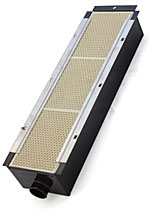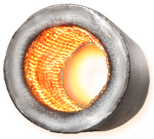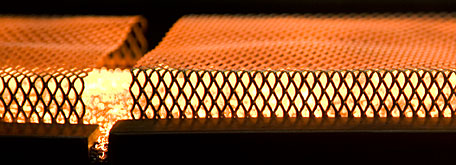e:
Radiant gas burner technologies
Ceramic burners
Since the beginning gas burners have been made from formed ceramic blocks where burning gas is directed on to the ceramic surface heating it to a temperature of around 600-900°C where it emits infrared radiation. Because it emits a  broad spectrum of radiation there is some visible light too and so the ceramic block glows an orange-red colour.
broad spectrum of radiation there is some visible light too and so the ceramic block glows an orange-red colour.
Ceramic burners can heat up and cool down within a few minutes and give a highly controllable form of heat.
- Directional
- Operates on all types of gas
- Operates in all orientations
- Single burners from 3kW to 19kW
- Building block approach allows custom burners
Metal fibre burners
Developments in metal alloys now let us replace the ceramic elements with a metal fibre material giving almost limitless potential to construct burners of all shapes and sizes - even to build burners that radiate internally.
The metal fibre, under the trade name 'Fecralloy'* is an Fe-Cr-Al steel alloy containing "yttrium" and suitable for use over a wide range up to 1300°C. Yttrium, a surprisingly common metallic element, is the key to its longer high temperature life, having greater oxidation resistance and form stability over other alloys.
 Metal fibre burners give us some further, major advantages...
Metal fibre burners give us some further, major advantages...
- Low thermal inertia - response in seconds
- Thermal & mechanical shock resistance
- Homogenous combustion
- High modulation capability
- Flashback safety
The high modulation capability allows us to control the temperature of the burner, and hence the wavelength of the emitted infrared, so we can match the burner output to the material being heated.
Premix gas Burners
A conventional gas burner emits gas into the burner assembly at speed via a small hole and this draws in air too. The resulting mixture usually contains around half of the air required for complete combustion and more air is drawn in directly to the flame. Such a burner gives poor flame control and can result in emissions of carbon monoxide (CO) and oxides of nitrogen (NOx) as well as relatively low flame temperature and mediocre fuel efficiency.
By carefully controlling air intake using a fan we can provide sufficient air for complete combustion without needing secondary air input at the flame itself. This gives much better control of the flame, higher flame temperature and lower emissions as well as better fuel economy for a given heat output.
Supersaver burners
Infraglo 'Supersaver' burners have an additional gauze or mesh fitted over the radiating surface. This reflects some of the infrared energy back to the surface and increases its temperature for the same fuel input. Put the other way around, it uses less fuel to achieve the same surface temperature and hence increases burner efficiency.

What we're saying, in a nutshell, is that whatever your burner requirements we have the technology to meet them. Metal fibre or ceramic?
Give us a call and put us to the test. We love a challenge!
page last updated: 03/12/2021
Infraglo (Sheffield) Ltd
Dannemora Drive
Greenland Road Industrial Park
Sheffield S9 5DF
e:
t: +44 114 249 5445
f: +44 114 249 5066
Sign up for our e-newsletter...




